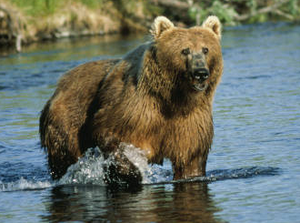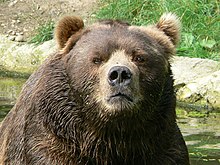Kodiak bear
| Kodiak bear | ||||||||||||
|---|---|---|---|---|---|---|---|---|---|---|---|---|

Kodiak bear ( Ursus arctos middendorffi ) |
||||||||||||
| Systematics | ||||||||||||
|
||||||||||||
| Scientific name | ||||||||||||
| Ursus arctos middendorffi | ||||||||||||
| Merriam , 1896 |
The Kodiak bear ( Ursus arctos middendorffi ) is a subspecies of the brown bear ( Ursus arctos ). It lives on Kodiak Island and the neighboring islands ( Afognak and Shuyak ) off the south coast of Alaska and is considered the largest land-based predator on earth , alongside the polar bear and the Kamchatka bear .
features
Kodiak bears reach a head body length of up to 2.8 meters, a shoulder height of up to 1.5 meters and a total length of up to 3 meters. The heaviest specimens reach a weight of almost 780 kilograms, the average weight is 389 kilograms for males and 207 kilograms for females. Kodiak bears are thus the largest subspecies of the brown bear. They have their usual build with a stocky body, long, strong limbs and a massive head; Coat color from beige to cinnamon brown to almost black. As with all bears, the tail is just a stub.
Way of life
The Kodiak bear's way of life largely corresponds to that of the other brown bears. He is a day and nocturnal loner and swims and climbs well. It is an omnivore that eats plants such as grasses, berries and roots as well as meat and carrion. An important role in the diet plays Fish: During the spawning migration of salmon in summer and autumn often gather dozens of animals at the rivers, the coveted food from the water to them to snap in the air fish or when fish cross small waterfalls.
If there is enough food, the animals are compatible with other species and the territories are significantly smaller than usual for bears in northern North America. During the cold months the Kodiak bear hibernates . Reproduction is also the same as that of the other brown bears. Mating usually takes place in June or July, but the fertilized egg does not implant until November. During hibernation (in January or February), one to three newborns are born in the hibernation den, which, like all bears, are tiny. The young stay with their mother for around two to four years.
Systematics
Today only two subspecies of the brown bear are usually recognized in North America, the Kodiak bear and the grizzly bear . The transitions are fluid, however, and the bears on the southern Alaskan coast are nearly as big and living the same way of life as the Kodiak bears.
Kodiak bears and humans
After the stock of Kodiak bears declined due to hunting, part of the island of Kodiak was placed under nature protection in 1941 . Today, under strictly limited guidelines, around 160 animals per year are released for shooting, the total population is estimated at around 3000 animals. The animals have also become a tourist attraction and play an important role in the region's tourism .
Trivia
A popular Kodiak bear was Bart the Bear . He played in films such as The Bear or On a Knife's Edge .


